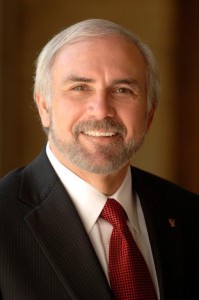Texas Tech President Guy Bailey, a finalist for the University of Alabama Presidential search, already spent six years at the University of Alabama, earning a bachelors and masters degree. Now, 38 years later, the Alabama grad may be returning; but this time he would be getting paid to oversee the 30,000-plus Alabama students seeking their own degrees.
Among the 30,000 students he currently serves, Bailey seems to have support due to his emphasis on research, open-door policy with students and efforts to diversify the Texas Tech student population.
“I really feel that Guy Bailey has made so many positive changes here at the university. He has extensively helped with our admissions process. He has also been just an amazing friend to all students,” said Alex Alston, SGA president at Texas Tech. “He really does care about the university and he shows by his actions.”
Many of Bailey’s cited contributions to Texas Tech include a ten-year business plan to become a tier-one school, increasing enrollment, and increasing diversity.
“A huge issue we had was the diversification of our student population,” Alston said. “Dr. Bailey took this issue to heart and started a university panel that worked with him to try and bring up suggestions that could help solve this. Dr. Bailey also created a group of University ambassadors whose mission was to help admissions recruit students to Texas Tech from all over.”
Bailey also increased the number of enrolled students in his time at Texas Tech. According to an article on Lubbock’s Local Fox34 website, in the fall of 2009 enrollment was at 30,000 students. By the fall of 2012, after continually increasing enrollments, Texas Tech saw a total enrollment of 32,327 students.
One of Bailey’s most prominently cited contributions though, comes from his 10-year business plan that would ultimately land Texas Tech among elite “Tier-One” schools.
The plan was put out this past March, and included a visual stairway to Tier-One membership, description of Tier-One schools, the benefits, and the business plan to land Texas Tech in the rankings of Tier-One schools.
In order to be a Tier One university, a school would need to either be a member of the Association of American Universities or have an AAU-like profile (which includes research, academic, and merit-based requirements), be ranked among the top 50 universities in the U.S. News and World Report, be a member of a BCS athletic conference, and be ranked in the Top 50 Carnegie Classification R/VH (research/very high).
Alston said Bailey has been one of the key people in pushing Texas Tech towards Tier One recognition.
According to LubbockOnline.com, Bailey mentioned plans to meet Gov. Rick Perry’s challenge for universities to create undergraduate programs that would cost students less than $10,000. The article states Bailey’s plan involved students taking 80 hours of coursework at a community college, then transfer to Texas Tech and take 40 hours of upper-division courses. The plan also included “reasonably priced” online academics.
From 1968-1974 Bailey received his Bachelor’s and Master’s degree from the University of Alabama in English. He then received his Ph.D. from the University of Tennessee in English Linguistics from 1974-1979.
Bailey has also written roughly 100 books and articles, many of which were written alongside his wife, Dr. Jan Tillery. The books and articles mostly cover subjects related to English, linguistics, dialects and language variation and change.
Bailey took over as President of Texas Tech University in August of 2008. According to texastribune.org, Bailey receives an annual salary of $350,000. Prior to serving as University President at Texas Tech, Bailey was chancellor at the University of Missouri-Kansas City.
Overall, Alston said he has had no negative experience with Bailey’s term as university president. Alston described Bailey as having an open door policy towards students, and striving to be visible around campus.
“I believe Dr. Bailey’s greatest strength would be his will to step out of his office and be among the university population, “ Alston said. “I also feel that he really cares about everything he does. He has this attention to detail that really helps the university strive to be among the best within Texas.”










